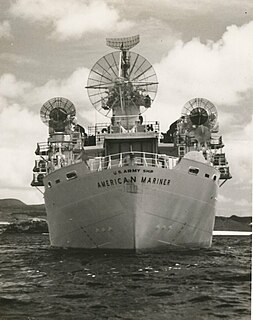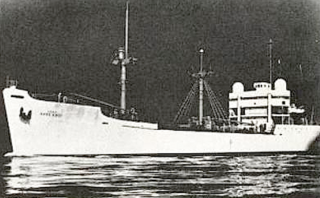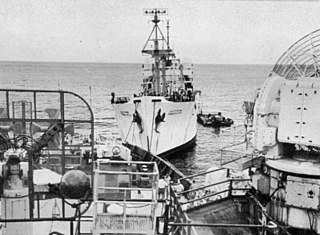 W
WUSAS American Mariner was a United States Army research vessel from January 1959 to 30 September 1963. She was originally assigned to the DAMP Project by the Advanced Research Projects Agency (ARPA) to attempt to collect radar signature data on incoming intercontinental ballistic missiles in the Caribbean, the South Atlantic Ocean, and the Indian Ocean. Her initial operations involved providing radar track on the Atlas missile, which was under development at the time. Subsequently, she provided track on other types of missiles as they proceeded through their development and operational stages. In September 1963 the original contract was transferred to the USAF until the completion of the testing phase in 1964.
 W
WUSNS Coastal Crusader (AK-220/ORV-16/T-AGM-16/AGS-36) was an Alamosa-class cargo ship that was constructed for the US Navy during the closing period of World War II. She was later acquired by the US Army in 1946 and the US Air Force in 1957 before being reacquired by the USN in 1964 and as a missile range instrumentation ship.
 W
WSS Dalton Victory was built as Victory ship used as a cargo ship for World War II under the Emergency Shipbuilding program. She was launched by the California Shipbuilding Company on 6 June 1944 and completed on 19 July 1944 as a Greenville Victory-class cargo ship. The ship’s United States Maritime Commission designation was VC2- S- AP3, hull number 21. She was acquired by the U.S. Navy in 1950 and renamed the USNS Dalton Victory (T-AK-256).
 W
WUSNS General Hoyt S. Vandenberg (T-AGM-10) was a General G. O. Squier-class transport ship in the United States Navy in World War II named in honor of U.S. Army Chief of Engineers Harry Taylor. She served for a time as army transport USAT General Harry Taylor, and was reacquired by the navy in 1950 as USNS General Harry Taylor (T-AP-145).
 W
WUSNS General H. H. Arnold (T-AGM-9) was a General G. O. Squier-class transport ship for the U.S. Navy in World War II. She was named in honor of U.S. Army general Robert Emmet Callan. She was transferred to the U.S. Army as USAT General R. E. Callan in 1946. On 28 April 1950 she was transferred to the Military Sea Transportation Service (MSTS) as USNS General R. E. Callan (T-AP-139). Placed in reserve in 1958, she was transferred to the U.S. Air Force in 1961 and renamed USAFS General H. H. Arnold in 1963, in honor of Henry H. Arnold, the first and only General of the Air Force. She was reacquired by the Navy in 1964 as USNS General H. H. Arnold (T-AGM-9). She was struck from the Naval Vessel Register on 1 March 1982.
 W
WSS Haiti Victory (T-AGM-238) was originally built and operated as Greenville class cargo Victory ship which operated as a cargo carrier in both the Atlantic Ocean and the Pacific Ocean during World War II.
 W
WUSNS Howard O. Lorenzen (T-AGM-25) is a Missile Range Instrumentation Ship built for the U.S. Navy by VT Halter Marine of Pascagoula, Mississippi. The keel was laid during a ceremony on August 13, 2008, and the vessel became operational in 2014. This ship carries a next-generation active electronically scanned array radar system named Cobra King.
 W
WUSNS Invincible (T-AGM-24), also known as ex-AGOS 10, is one of two tracking ships operated by the Military Sealift Command. One of the radars it carries is the Cobra Gemini dual band, X band and S band, radar.
 W
WSS Mission San Fernando was a Type T2-SE-A2 tanker built for the United States Maritime Commission during World War II. After the war she was acquired by the United States Navy as USS Mission San Fernando (AO-122). Later the tanker transferred to the Military Sea Transportation Service as USNS Mission San Fernando (T-AO-122). She was a member of the Mission Buenaventura-class oiler and was named for Mission San Fernando Rey de España in Los Angeles. She was later renamed USNS Muscle Shoals (T-AGM-19), and, later, USNS Vanguard (T-AG-194).
 W
WSS Mission San Juan was a Type T2-SE-A2 tanker built for the United States Maritime Commission during World War II. After the war she was acquired by the United States Navy as USS Mission San Juan. Later the tanker transferred to the Military Sea Transportation Service as USNS Mission San Juan. She was a member of the Mission Buenaventura-class oiler and was named for Mission San Juan Bautista in San Juan Bautista, California.
 W
WUSNS Observation Island (T-AGM-23) was built as the Mariner-class merchant ship Empire State Mariner for the United States Maritime Commission, launched 15 August 1953, and operated by United States Lines upon delivery on 24 February 1954, making voyages for the Military Sea Transportation Service (MSTS) until going into reserve at Mobile, Alabama on 9 November 1954. Title was transferred to the United States Navy on 10 September 1956 and, after conversion, the ship was renamed Observation Island. On commissioning the ship was classified as the "experimental miscellaneous auxiliary" (EAG), USS Observation Island (EAG-154) supporting fleet ballistic missile development. On 1 April 1968 Observation Island was redesignated as a miscellaneous auxiliary USS Observation Island (AG-154). Observation Island was decommissioned and placed in reserve from 1972 until 1977 in the Suisun Bay Reserve Fleet until withdrawn and then returned in 1978. The ship was permanently withdrawn April 1979 and placed in service with MSTS successor, the Military Sealift Command.
 W
WUSNS Private Joe E. Mann (T-AK-253) was a Boulder Victory-class cargo ship acquired in 1950, from the U.S. Army, where she was known as the USAT Private Joe E. Mann.
 W
WUSNS Range Recoverer (T-AG-161/T-AGM-2/YFRT-524) was a missile range instrumentation ship responsible for providing radar and/or telemetry track data on missiles launched from American launch sites.
 W
WUSNS Range Tracker (T-AGM-1/T-AG-160) was an Air Force Systems Command Range Tracker-class missile range instrumentation ship. She was acquired from the National Defense Reserve Fleet in the 1950s and converted into a missile range tracking ship with a civilian crew. She performed tracking duties from 1961 through 1969 on the Western Launch and Test Range.
 W
WUSNS Redstone, designated T‑AGM‑20, was a tracking ship assigned to Apollo space mission support under the control of the Eastern Range. For a brief time during conversion the ship was named Johnstown with the designation AGM‑20.
 W
WUSNS Rose Knot (T-AGM-14) was a World War II era United States Maritime Commission small cargo ship built in 1945 and delivered to the War Shipping Administration for operation through agent shipping companies and for periods by the Military Sea Transportation Service (MSTS). In 1957 the ship was transferred to the Air Force and converted into a missile range instrumentation ship which operated as USAFS Rose Knot on the U.S. Air Force's Eastern Test Range during the late 1950s and early 1960s. Rose Knot operated under an Air Force contract with Pan American Airways Guided Missile Range Division headquartered in Cocoa Beach, Florida. In July 1964 all Air Force tracking ships were transferred to MSTS for operation with the Air Force in operational control while the ships were at sea as tracking ships. Rose Knot had special facilities for supporting the manned space program and supported the early manned flights. The ship was owned by the U.S. government until sold for non transportation use in 1977.
 W
WUSS Sherburne (APA-205) was a US Navy Haskell-class attack transport, built and used during World War II. She was of the VC2-S-AP5 Victory ship design type. Sherburne was named for Sherburne County, Minnesota. She was later converted and renamed USS Range Sentinel (AGM-22), a missile range instrumentation ship.
 W
WUSNS Sword Knot (T-AGM-13) was a missile range instrumentation ship which operated as USAFS Sword Knot on the United States Air Force's Eastern Range during the late 1950s and early 1960s. Sword Knot operated under an Air Force contract with Pan American Airways Guided Missile Range Division headquartered in Cocoa Beach, Florida.
 W
WUSNS Timber Hitch (T-AGM-17) was a U.S. Navy missile range instrumentation ship which earlier operated as the U.S. Air Force Ocean Range Vessel USAFS Timber Hitch (ORV-17) on the U.S. Air Force's Eastern Test Range during the late 1950s and early 1960s. Timber Hitch operated under an Air Force contract with Pan American Airways Guided Missile Range Division headquartered in Cocoa Beach, Florida.
 W
WUSNS Watertown (T-AGM-6) was a Watertown-class missile range instrumentation ship acquired by the U.S. Navy in 1960 and converted from her SS Niantic Victory Victory ship cargo configuration to a missile tracking ship, a role she retained for eleven years before being placed out of service in 1971.